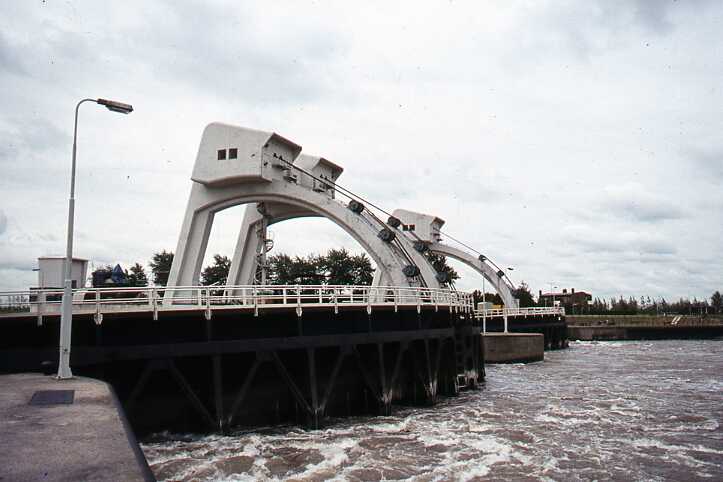Passive defence
When flooding increasingly became a problem, people initially built artificial mounds (terpen) in a number of areas. In the period between 1000 and 1250, this passive form of defence was gradually replaced by a more active one - the construction of dikes.
Active defence
The first dikes were built in the eleventh century, after which the dike system was further expanded and improved. At the same time, large-scale cultivation of the wet peat areas began, especially in the western part of the Netherlands. However, the drainage of the peat led to a significant further subsidence of the soil. In addition, peat was also excavated on a large scale for fuel. In the period between 1350 and 1600, drainage by windmills provided a solution, so that the increasingly lower lands could continue to be used for agricultural purposes. This also saw the introduction of canal systems in the landscape. These canal systems with a level of a few decimetres below NAP, to which the polders discharge their excess water and through which the water is discharged to the North Sea, the rivers, or the IJsselmeer. Initially, the discharge from these systems could take place through sluices. Due to the stricter requirements that are now imposed on the water level control in the canal systems, pumping stations have now been installed in addition to most discharge sluices. It is interesting that while the preferred water level in the polders has always been adjusted to the lower elevation, the preferred water level in the canal systems has remained virtually unchanged over the centuries.
The windmill also made it possible to drain lakes. The first drained lake, the Achtermeer near Alkmaar, was created in 1533. In addition, much land was reclaimed during this period by building dikes on silted-up soils along the coast and the inland seas. Among other things, the ample availability of capital and high grain prices led to the draining of countless lakes, which together cover several tens of thousands of hectares.
The modernisation of society in the nineteenth and twentieth centuries is reflected in the transition of the Netherlands from a rural to an urbanised society. In addition, technical innovations heralded a new era, steam power made large and powerful machines possible, which made extensive projects technically feasible. For example, the Haarlemmermeer - approximately 18,100 hectares - was drained between 1848 and 1852 by three steam power pumping stations. In addition, safety against river flooding could finally be significantly improved.
Water quantity management
With regard to water quantity management, we see a tightening of the standards that the systems must meet over the centuries, as well as a shift towards less storage area and a larger pumping capacity. It is not really known which conditions were achieved with the original water management systems. This is much better known with regard to pumping by windmills. During this period, which lasted at least until the early nineteenth century, efforts were made to ensure that the lands became dry by early April, so that one crop could be grown before the lands became waterlogged again, or completely submerged, during October and November.
The introduction of steam power pumping in the middle of the nineteenth century led to much greater possibilities and at that time insights in the field of agriculture also changed. As a result, from the end of the nineteenth century onwards there was an effort to maintain a relatively low water level during the winter. This continued when diesel and electrical pumping were introduced at the beginning of the twentieth century, which also made better water level management possible.
After the Second World War, strong urbanisation and industrialisation started. In many cases, the areas were raised above the water level in the canal systems. Since the seventies of the twentieth century this has been less and less the case and people increasingly choose a surface level in relation to the water level in the polder. The accelerated water discharge from these areas naturally influences the requirements that must be set for the storage and pumping in the polder in question.
Although not directly expressed in the standards, they are nevertheless based on the fact that investments in water management in particular are an optimum between costs and yield reductions to agricultural crops, or damage to buildings and infrastructure. The standards used here were mainly established in the fifties and sixties of the twentieth century. Since then, the value per hectare has increased significantly and there is a certain influence of climate change, so that in recent years there have been some reconsiderations that have led to stricter standards.
Conclusion
In the past, population growth, with the resulting need for higher food production and the desire to improve living conditions, formed incentives for change. New developments in water management in the Netherlands were partly made possible by technical innovations, such as the windmill and the steam engine.
Social factors determined the emergence of a strong social structure, such as the formation of Water Authorities. These have been able to provide collective operation and maintenance of water management systems for centuries. A strong Authority, Rijkswaterstaat, is of great importance in this respect in order to guarantee water management and protection against flooding at the National level. Social factors form essential building blocks in the development of water management. The above-mentioned factors can easily be recognised in the history of water management in the Netherlands. This created a vulnerable area that can only survive thanks to advanced technical resources and permanent vigilance.

